The Little TPO That Could
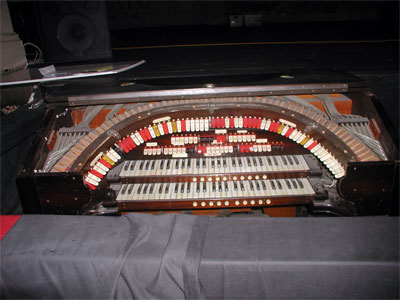
The console of the San Bernardino Style 216 2/10 Mighty WurliTzer
Theatre Pipe Organ sitting in the pit with the horseshoe lid open.
The Style 216 Mighty WurliTzer Theatre Pipe Organ was one of the rarest small WurliTzers ever made, with only twelve being built. It was the instrument which Jim Henry chose to use as his specification for the Mighty MidiTzer 216. This organ is known lovingly as is "The Little TPO That Could".
In the picture above, we see the console of the San Bernardino Style 216 2/10 Mighty WurliTzer as it sits in the pit today, with the horseshoe lid open showing the stop action. The organ is undergoing restoration.
Notice the many small tubes that supply air to the leather and wood pouches that operate the stop tongues when a thumb piston is pressed. The tubes are connected on the other end to what are referred to as blow boxes, little mini-regulators fed by the main wind line. Each set of stops has its own blow box. This is what made the consoles of even the tiny Theatre Pipe Organs so big.
A small organ has a sound that the bigger intruments do not. Each rank is more distinct, for there are not as many. The Style 216 2/10 Mighty WurliTzer had ten ranks of pipes playable from two keyboards and a pedalboard. There are 62 stop tongues in the console controlling the ten ranks and pistons for the many tuned percussions such as drums and cymbels, birds, chimes, harps, and bells, etc. The pipes were in two chambers, one on each side of the movie screen.
The Rialto WurliTzer
Another example of the twelve installations, the Rialto Theatre's Style 216 2/10 Mighty WurliTzer Theatre Pipe Organ, was made famous by the legendary George Wright during the late sixties through the mid seventies. George recorded several albums on this fine instrument, the most notable of which is one entitled Live at the Rialto, a double CD set featuring twenty great tunes that have become the defining standard by which all other TPO music is judged. George made this little organ sound like a giant!
You can purchase a copy of Live at the Rialto by clicking here, which will take you to the Walnut Hill General Store. Go to Featured Merchandise and look for the album art for "Live at the Rialto". Click the art to go to Banda Records, distributors for many wonderful TPO records. George has his own section at Banda.
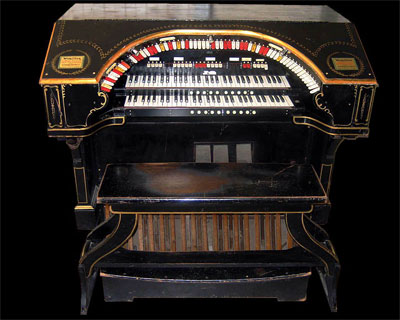
Console of the Rialto Theatre's
Style 216 2/10 Mighty WurliTzer Theatre Pipe Organ.
This humble machine was like many to be found all across America before the Great Depression. Since then, almost all the little TPO's have vanished, either by vandel, act of God, or as is more common, swallowed up by the manufacture of larger machines.
In the late seventies, the Rialto Theatre in Pasadena, California caught fire and all that remained of the instrument were the console and three ranks of pipes. Bob Loech aquired and stored the remains in his garage for a time until he could decide what to do with them. Last year, a deal was struck to put the organ back in the Rialto after restoration of the building and the organ.
According to Bob Loech, former owner of Opus 1142, on July 8th of 2006 the Rialto console went home to the Southland, and took up temporary residence in the Meridian Ironworks Building, 913 Meridian Avenue, South Pasadena. While not ideal, at least the console will be visible for anyone to see, and will hopefully help drum up interest in restoring both the theatre and the organ.
Building A Replica Of
The San Bernardino WurliTzer
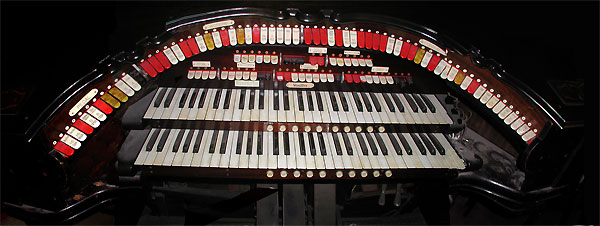
San Bernardino 2/10 Mighty WurliTzer Style 216 Console stop sweep.
Walnut Hill Wall of Famer Paul Kealy tells us the story of how he intends to build a digital replica of the the San Bernardino Style 216 2/10 Mighty WurliTzer Theatre Pipe Organ using a converted Conn console ataached to a computer via MIDI and running the Mighty MidiTzer 216.
I'll make it fit yet!
Although I have been nibbling away the struts between the Conn horseshoe divisions to allow the additional WurliTzer tabs to fit where the Conn had 52, I have still ran out of space. To replicate the tab layout of the San Bernardino console faithfully I have to concider the following facts.
When comparing enlarged photos, I see the difference between the Style 216 at the Rialto in Pasadena and the San Bernardino Style 216. The San Bernardino WurliTzer has two additional tabs!
Rialto - 62 stops , single row back rail
San Bernardino - 64 stops, double row back rail
Could the extra stops on the San Bernardino organ be the 16' and 4' Voxes, perhaps?
By detaching the lower lip of the horseshoe "smile" that was created when the long "mouth" was manufactured after the Conn horseshoe was engineered, through which the "tongues" of the tabs protrude, and separating this lower piece from the liftable lid. I can attach this lower piece to the bottom of the console desk below the curved stop rail, engineering it as part of the back rail that houses the two rows of tabs to the rear and above the keyboards.
If I eliminate a full tab space and replace it with one of those narrow divider thingies from Arndt, and scoot the 33 solo tabs about a half inch to the left, I can fit 63 tabs on the Conn horseshoe stop rail. I noted the San Bernardino Style 216 console has no full spaces between the divisions.
If I then relocate some tabs from the horseshoe stop rail to the back rail, I forsake the look and feel of the organ it seeks to emulate and I still have to find a place to put these tabs below on a custom fallboard below the stop rail. However, by relocating the Acc to Pedal tab from the stop rail and moving it down to the back rail, I only need spaces for 63 stops up there on top. That is a minimum sacrifice, but still over my 62-tab minimum. I max out at 63 stops.
Remember, replacing the original third Conn solo keyboard as I retrofit two Wurli keyboards into the space of the console previously populated by three Conn keyboards gives me more "floor space" on the console deck for s back rail that can hold two rows of tabs. The top lid of the console to which the horseshoe stop rail is attached, closes down on the fallboard above the keydesk.
Whatever choices are finalized, I am creating a prototype replica based on how it sits in the pit today, including whatever restorative or modified changes are ultimately created in the spirit of the original. My goal is to provide the look and feel of that instrument in this touring virtual instrument, and trying to cram those additional stops has been a challenge.
Whatever ranks the San Bernardino WurliTzer eventually contains will be matched within my console replica, since it is powered by Bruce Miles' SoundFonts loaded into the MidiTzer engine. The MidiBox kits are on order and they should arrive in a few days. I can then begin soldering and assembling circuit boards to actuate the switches for the MidiTzer software.
We look forward to seeing Paul Kealy complete hus project. Stay tuned for pictures and news as the story unfolds...
A Closer Look At The
San Bernardino WurliTzer
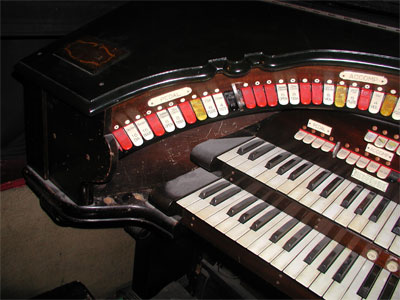
The left bolster of the console.
Here, we see the left bolster containing the Pedal and Accompaniment stops.
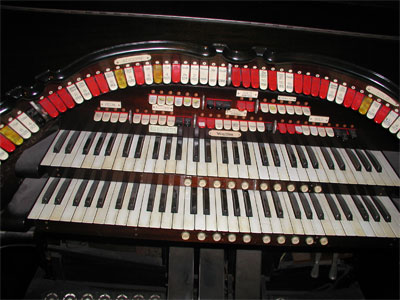
The center bolster and fallboard of the console.
In the picture above, we see a close up of the stop sweep showing the back rail and fallboard.
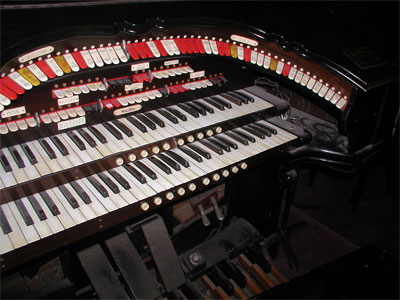
The right bolster of the console.
Here we see the right bolster of the console containing the Solo stops.
|






